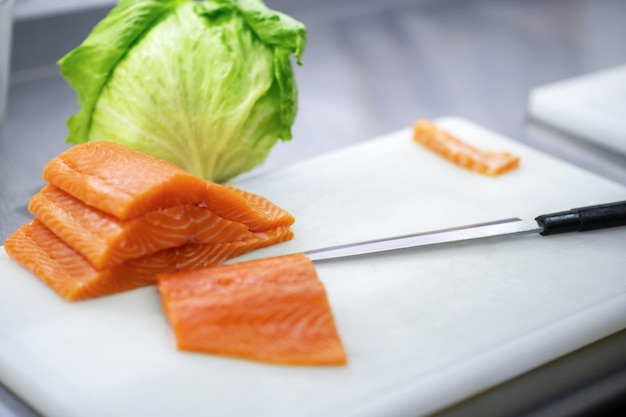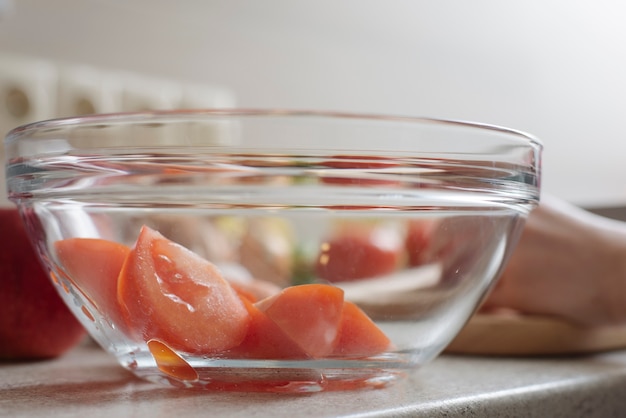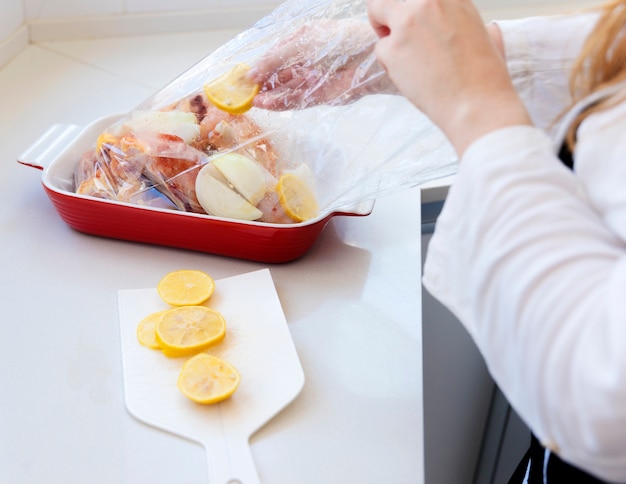As a seasoned article editor, I've spent countless hours in kitchens, experimenting with recipes from every corner of the world. But sometimes, the simplest meals are the most satisfying. That's why I hold a special fondness for baking frozen salmon. It's a quick and easy way to enjoy a delicious and healthy meal, even on busy weeknights. And trust me, there's nothing quite like the aroma of perfectly baked salmon filling your home!
But let's face it, baking frozen salmon can be a bit tricky. You don't want to end up with dry, overcooked fish, or worse, a raw centre. That's where this comprehensive guide comes in, sharing my personal tips and tricks for achieving that perfect, succulent bake every time. From choosing the right salmon to understanding cooking times, I'll walk you through every step of the process, ensuring your meals are always flavourful and enjoyable.
Part 1: Selecting the Perfect Frozen Salmon

1.1 Knowing Your Options: Navigating the Frozen Salmon Aisle
Frozen salmon comes in a variety of forms, each with its own unique advantages and disadvantages. Let's explore the most common types:
- Individually Quick Frozen (IQF) Salmon Portions: These are ideal for smaller households or when you're cooking for one or two people. They're easy to separate, thaw quickly, and allow for portion control. I often use them for quick and simple weeknight meals.
- Frozen salmon fillets: Typically sold in packs of two or three, they're perfect for a family meal or when you want to cook larger portions. While they generally require a bit longer to thaw than IQF portions, they offer a more substantial serving size.
- Frozen Salmon Steaks: These thicker cuts of salmon are ideal for grilling or baking, offering a more substantial meal and a richer flavour. They need a longer thawing time than fillets, but their thickness allows them to hold their shape well during cooking.
1.2 The Art of Choosing Quality Salmon: Ensuring Freshness and Flavor
Just like with fresh salmon, quality is paramount when choosing frozen salmon. Here's how to pick the best:
- Bright, Even Colour: The flesh should be a deep, vibrant pink or orange. Avoid salmon with pale or faded colours, as this can indicate that it's not as fresh. I always try to select salmon with a vibrant, almost iridescent hue.
- Firm Texture: The flesh should be firm and springy to the touch, similar to the texture of fresh salmon. Avoid salmon that feels mushy or watery, as this suggests that it has been frozen and thawed multiple times.
- Minimal Ice Crystals: Excessive ice crystals are a sign that the salmon has been frozen and thawed multiple times, which can affect its flavour and texture. Ideally, choose salmon with minimal ice crystals and a smooth, even surface.
It's also crucial to check the expiry date and storage conditions. Ensure the salmon is kept frozen at the appropriate temperature to maintain its quality and prevent freezer burn. I always double-check the packaging to ensure it's been properly stored and that the expiry date is well within the future.
Part 2: Thaw It Out: Decoding the Secrets of Defrosting

2.1 The Overnight Thaw: A Classic Approach for Even Thawing
For the best results, I recommend thawing your frozen salmon overnight in the refrigerator. This slow and gradual method allows the salmon to thaw evenly, preventing ice crystals from forming and maintaining its moisture. Simply place the frozen salmon in a sealed container or resealable bag and transfer it to the refrigerator. The recommended thawing time for a 1-pound salmon fillet is around 8-10 hours. This is my go-to method as it's simple, hassle-free, and guarantees the best results.
2.2 The Cold water bath: A Time-Saving Option for When Time is Short
If you're short on time, the cold water bath method can be a lifesaver. Simply place the frozen salmon in a sealed container or resealable bag and submerge it in a bowl of cold water. Change the water every 30 minutes to ensure the salmon thaws evenly. This method takes approximately 30-45 minutes for a 1-pound salmon fillet. Just remember to keep the salmon submerged and the water cold.
I usually resort to the cold water bath when I've forgotten to thaw the salmon overnight or need a quick solution. However, I always find the overnight method produces the best results.
2.3 The Microwave Defrost: A Quick Fix (with Caution) for Emergencies
While tempting for its speed, I typically avoid using the microwave to defrost frozen salmon. The rapid heating can lead to uneven thawing and potential overcooking. However, if you must use the microwave, use the "defrost" setting and check the salmon frequently to ensure it thaws evenly. Remember, this method is best for smaller portions and should be used with caution. It's a last resort for me, and I always monitor the salmon carefully to prevent overcooking.
Part 3: Preparing the Salmon for Baking: A Symphony of Flavours

3.1 Seasoning Savvy: Creating a Flavor Profile that Sizzles
The beauty of baking salmon is its versatility. It readily absorbs flavours, making it a blank canvas for culinary creativity. I love experimenting with different seasonings and herbs, creating flavour profiles that tantalise the taste buds. Here are a few of my favourites:
- Simple and Classic: Salt, pepper, and lemon juice are a timeless combination. The salt enhances the salmon's natural flavour, pepper adds a touch of spice, and the lemon juice brightens the flavour and adds a touch of tang. This classic combination is always a winner and complements the salmon beautifully.
- Mediterranean Inspiration: A blend of dried herbs like oregano, thyme, rosemary, and basil adds a fragrant touch to the salmon. A drizzle of olive oil and a sprinkle of red pepper flakes elevate the flavour further. I find this combination to be especially delicious with roasted vegetables.
- Asian Flavours: A mix of soy sauce, ginger, garlic, and sesame oil creates a delicious and umami-rich glaze. This marinade infuses the salmon with a rich, complex flavour.
- Spice It Up: For a bolder flavour, add a pinch of paprika, cayenne pepper, or chili powder to your seasoning mix. This is a great option for those who enjoy a bit of heat.
You can also experiment with citrus zest, garlic powder, onion powder, or even a dash of smoked paprika for a smoky flavour. Remember, the best way to discover your favourite seasonings is to experiment and have fun!
3.2 The Art of the Marinade: Infusing Flavor and Moisture for a Tender Finish
Marinating your salmon before baking can enhance its flavour and tenderness. It's especially beneficial for frozen salmon, as it helps to rehydrate the fish and infuse it with delicious aromas. Here are a few of my go-to marinade combinations:
- Lemon-Herb Marinade: A mixture of lemon juice, olive oil, garlic, fresh herbs like parsley, dill, or thyme, and salt and pepper adds a bright and refreshing flavour to the salmon. This marinade is perfect for a light and summery meal.
- Soy-Ginger Marinade: A mix of soy sauce, grated ginger, garlic, honey, and sesame oil creates a sweet and savoury marinade that infuses the salmon with a rich flavour. This marinade is perfect for those who enjoy Asian-inspired flavours.
- Spicy Mango Marinade: Blend mango puree, chili powder, lime juice, cilantro, and a touch of honey for a sweet and spicy marinade that complements the salmon beautifully. This marinade adds a touch of tropical flair to your meal.
The key to marinating frozen salmon is to let it thaw in the marinade itself. This ensures even flavour penetration. I usually marinate it for at least 30 minutes, but for a deeper flavour, I let it marinate for 2-4 hours in the refrigerator.
Part 4: Baking Frozen Salmon: The Ultimate Guide to Perfection
4.1 The Baking Dish: Selecting the Right Vessel for a Flawless Bake
A baking dish is your canvas for creating a masterpiece. Here's what to consider when choosing one:
- Size: Choose a baking dish that's large enough to accommodate the salmon fillets or steaks without crowding them. The salmon needs space to cook evenly and develop a crispy skin. I typically use a 9x13 inch baking dish for a standard 1-pound salmon fillet.
- Material: Glass, ceramic, or metal baking dishes are all suitable options. Avoid using thin, flimsy baking dishes that might warp or crack in the oven. I prefer glass or ceramic baking dishes, as they distribute heat evenly and are less likely to warp.
- Non-Stick Surface: Non-stick baking dishes are a great choice for easy cleanup. They prevent the salmon from sticking and help to maintain its moisture. I always opt for non-stick baking dishes to simplify the cleaning process.
4.2 Preheating the Oven: Creating the Perfect Environment for a Golden Crust
Preheating your oven is crucial for ensuring even cooking and achieving that golden-brown crust. Preheat the oven to 400°F (200°C) for optimal results. I always preheat my oven for at least 10 minutes to ensure it reaches the desired temperature.
4.3 Setting the Stage: Preparing the Baking Dish for a Smooth Experience
Before placing the salmon in the baking dish, line it with parchment paper or aluminum foil. This not only prevents sticking but also makes cleanup a breeze. If you're not using parchment paper or aluminum foil, grease the baking dish lightly with oil or butter. This will help to prevent the salmon from sticking to the surface. I always prefer to use parchment paper, as it's easy to remove and prevents the salmon from sticking to the pan.
4.4 Layering the Salmon: Ensuring Even Cooking for a Perfectly Baked Meal
Gently place the thawed salmon fillets or steaks in the baking dish, leaving some space between each piece. If you're baking multiple salmon fillets, arrange them in a single layer to ensure they cook evenly. I make sure to arrange the salmon so that each piece has enough space to cook evenly and develop a beautiful golden crust.
Part 5: The Baking Process: Timing and Temperature for a Flawless Salmon
5.1 The Temperature Guide: Unlocking the Secrets to perfect salmon
Here's a general guideline for baking frozen salmon at 400°F (200°C):
| salmon thickness | Baking Time |
|---|---|
| 1/2 inch | 10-12 minutes |
| 1 inch | 15-18 minutes |
| 1 1/2 inches | 20-25 minutes |
Keep in mind that these are just estimates. The actual baking time may vary depending on the size and thickness of your salmon, the type of oven you're using, and your preferred level of doneness.
I usually err on the side of caution and check the salmon a few minutes before the recommended time. It's better to undercook it slightly than to overcook it.
5.2 The internal temperature Test: Ensuring Safety and Perfection for a Safe and Delicious Meal
The best way to ensure that your salmon is cooked through is to use a meat thermometer. Insert the thermometer into the thickest part of the salmon, making sure not to touch the bone. The salmon is cooked through when it reaches an internal temperature of 145°F (63°C).
I always have a meat thermometer on hand for cooking salmon, as it's the most reliable way to ensure it's cooked to perfection. It eliminates any guesswork and ensures a safe and delicious meal.
5.3 The Visual Cues: Signs of Doneness for Those Without a Thermometer
If you don't have a meat thermometer, there are some visual cues to help you determine if your salmon is cooked through:
- Colour: The salmon will turn from a translucent pink to an opaque white or light pink colour when it's cooked.
- Flaking: The flesh will flake easily when cooked through.
- Appearance: The skin will become crisp and slightly brown.
While these visual cues can be helpful, they're not as reliable as using a meat thermometer. If you're unsure, it's always better to err on the side of caution and cook the salmon a little longer.
Part 6: Resting the Salmon: Unlocking Flavor and Moisture for a Juicy Delight
After removing the salmon from the oven, let it rest for 5-10 minutes before serving. This allows the juices to redistribute, resulting in a more tender and flavourful salmon. I always allow the salmon to rest before serving, and it makes a noticeable difference in its texture and flavour.
Part 7: Serving the Salmon: A Symphony of Flavors and Textures for a Well-Balanced Meal
Serve the baked salmon with your favourite sides, such as:
- Roasted vegetables: Broccoli, asparagus, carrots, or Brussels sprouts complement the salmon beautifully. I love pairing salmon with roasted vegetables, as the flavours meld together beautifully.
- Rice or quinoa: A bed of rice or quinoa provides a hearty base for the salmon. I find that rice or quinoa adds a nice balance to the meal, providing a more filling and satisfying experience.
- Salad: A fresh and vibrant salad adds a refreshing touch to the meal. I often serve a green salad with a light vinaigrette to cut through the richness of the salmon.
- Lemon wedges: Squeeze a bit of lemon juice over the salmon for a bright and tangy flavour. I find that a squeeze of lemon juice enhances the flavour of the salmon and adds a touch of brightness to the dish.
Get creative and experiment with different combinations to discover your favourite pairings.
Part 8: leftover salmon: A Culinary Treasure for Delicious Reinventions
If you have leftover baked salmon, don't despair! It can be used in various delicious ways:
- Salmon salad: Flake the leftover salmon and combine it with mayonnaise, chopped celery, red onion, and a squeeze of lemon juice for a tasty and satisfying salad. This salad is a great option for a light lunch or dinner.
- Salmon pasta: Add the leftover salmon to your favourite pasta dish. It's especially delicious with creamy sauces like Alfredo or pesto. I find that salmon adds a nice protein boost and flavour to pasta dishes.
- Salmon soup: Use the leftover salmon to make a hearty and flavorful soup. This is a great way to use up leftover salmon and create a warm and comforting meal.
- Salmon sandwiches: Combine the leftover salmon with your favourite sandwich fillings for a quick and easy lunch. Salmon sandwiches are always a crowd-pleaser, and they're a great way to use up leftover salmon.
Leftover salmon is a culinary treasure that can be used in many creative and delicious ways. It's a great way to avoid food waste and create new and exciting dishes.
Part 9: FAQs: Unveiling the Mysteries of baked frozen salmon
Here are some frequently asked questions about baking frozen salmon:
9.1 Can I bake frozen salmon without thawing it first?
While you can technically bake frozen salmon, it will take longer to cook and might not cook evenly. It's generally recommended to thaw frozen salmon before baking for optimal results. I always thaw my salmon before baking, as it ensures even cooking and prevents a raw centre.
9.2 What if my salmon is overcooked?
overcooked salmon can be dry and tough. To prevent this, use a meat thermometer and bake the salmon according to the instructions provided in this guide. If you do overcook the salmon, there are still ways to salvage it. You can add it to a pasta dish or a soup, where the texture won't be as noticeable.
9.3 Can I use frozen salmon for grilling or pan-frying?
You can absolutely use frozen salmon for grilling or pan-frying. Just be sure to thaw it thoroughly before cooking. I find that frozen salmon works well for grilling or pan-frying as long as it's thawed properly.
9.4 How long can I keep frozen salmon in the freezer?
Frozen salmon can be stored in the freezer for up to 3-6 months. For best quality, use it within 3 months. I always try to use frozen salmon within 3 months to ensure it maintains its best quality.
9.5 What are some tips for cooking frozen salmon to perfection?
Here are some additional tips for baking frozen salmon to perfection:
- Use parchment paper or aluminum foil: This will prevent sticking and make cleanup a breeze.
- Bake the salmon at a high temperature: This will help to create a crispy skin and cook the salmon through quickly.
- Use a meat thermometer: This is the most accurate way to ensure that your salmon is cooked through.
- Let the salmon rest before serving: This will allow the juices to redistribute and result in a more tender and flavourful salmon.
I hope this guide has given you all the information you need to bake frozen salmon to perfection. Happy cooking!
Everyone is watching

Perfect Rice Every Time: The Ultimate Guide to Cooking Rice
Cooking TipsAs a self-proclaimed foodie, I've always been a bit obsessed with rice. It's the foundation of countless cuisi...

Prime Rib Roast Cooking Time Chart: Per Pound Guide
Cooking TipsPrime rib roast. Just the name conjures images of lavish dinners, crackling fires, and hearty laughter. It’s ...

The Ultimate Guide to Cooking Asparagus: Tips, Techniques, and Recipes
Cooking TipsAsparagus. The mere mention of this spring delicacy conjures up images of vibrant green spears, crisp and burs...

Ultimate Guide to Cooking the Perfect Thanksgiving Turkey
Cooking TipsThanksgiving. Just the word conjures up images of overflowing tables laden with delicious food, the scent of r...

How Long to Bake Potatoes in the Oven (Perfect Every Time)
Cooking TipsBaked potatoes are a staple in my kitchen. They're incredibly versatile, delicious, and surprisingly easy to m...
